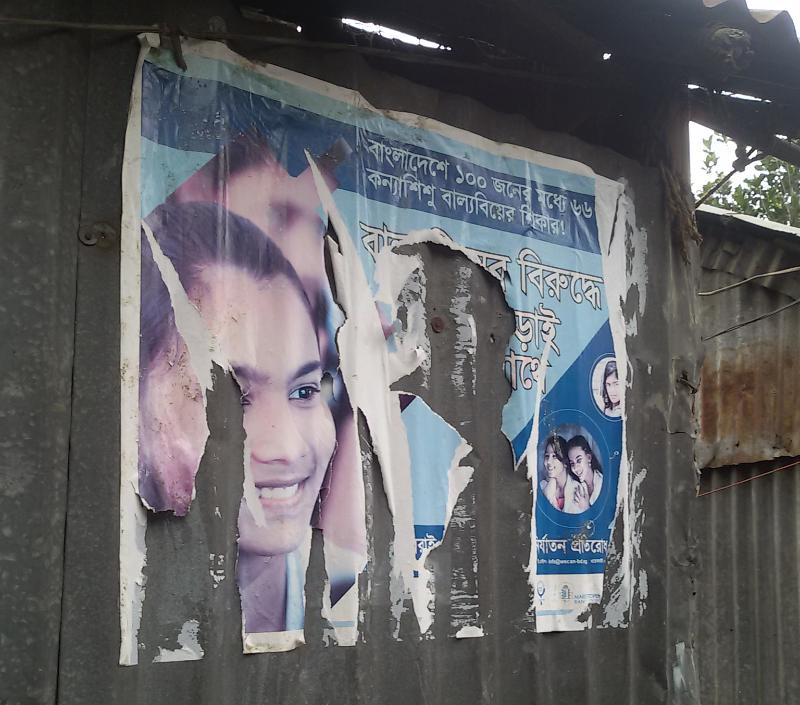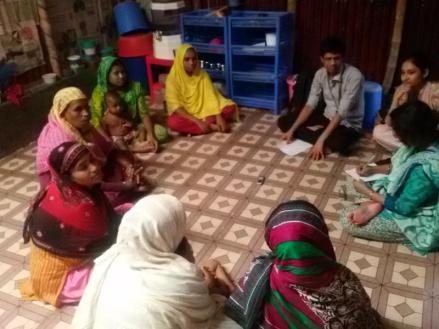
Although only 16 years old, Ayesha had already been married for nine months when we met her in the Bhashantek slum in Mirpur, Dhaka. While conducting research for the Preventing Early Child Marriage in Urban Slums project, we spoke to Ayesha to get a better understanding of the reasons behind her decision to marry. This is her story.
As an orphan from birth, the responsibility for Ayesha’s care fell on her grandmother. But when her grandmother also died, Ayesha was passed on to the care of one of her paternal aunts. Unfortunately, this arrangement didn’t last either, as Ayesha’s uncle was not keen on having another mouth to feed.
She was then sent to live with another aunt and her cousin who wilfully took her in their care. They loved Ayesha and it seemed that she was finally happy. But when her cousin married a few years later, his new wife disliked Ayesha’s presence and treated her badly. She refused to sit or eat at the same table as Ayesha and blamed her for everything that went wrong in the house. This made life so unbearable for Ayesha that she decided her only option was to get married and move out of the house.
The first suitor her aunt found for Ayesha was interested in the union until his family found out she was an orphan. “His parents were concerned that their son would miss out on jamai-ador (the cultural tradition of pampering the son-in-law with food, accommodation, dowry and all other means of hospitality),” said Ayesha.
The next suitor was Ayesha’s distant cousin. “I heard that he loved me,” she said. “I was so desperate to get married and have a home that I said yes to him. I did not think of anything else.” But after they got married, Ayesha realized the magnitude of responsibilities that came along with being a wife. “I had never seen a wooden stove before getting married,” she said. “But I needed to cook on that stove now. I never cooked or washed clothes before [getting married]; now I have to do all that and more.”
Even though she performs her daily chores, Ayesha’s husband is still displeased and uses any opportunity to beat her. “I cannot sleep on my right side from the beating he gave me last time.”
Now she regrets the decisions she made, which led up to her getting married in such haste. She says that one of the greatest impacts of her marriage is the loss of her independence. “I could go to my cousin’s house whenever I wanted to go. I used to visit Dhanmondi Lake every afternoon with my aunt. But now I don’t have that independence. I want to visit her, but I can’t.”
In addition to Ayesha’s loss of freedom, she now faces pressure to have a baby. “My husband and in-laws want me to have a baby as soon as possible,” she said. “They do not think of my age and that I am only 16.”
Ayesha decided to get married because she felt she had no other way out. She could no longer tolerate the difficulty of living in the same house as her cousin’s new wife. She believed that marriage would give her a better life. But at just 16 years old, she has lost her childhood and opportunities for a brighter future.

In a country where 64% of girls are married before the age of 18, it is crucial to examine how to end this all too common practice, and empower girls to overcome the hardships, which lead them to seek early marriage as a means to escape their difficulties.
This particular project on preventing early child marriage is examining the underlying factors that lead girls and their families to make such decisions. While Ayesha’s story is only a snapshot of the research being conducted, the three-year long project will delve deeper into identifying how to delay early marriage and its impact on both girls and boys. Ultimately, the findings from this project aims to help the Government of Bangladesh inform future programme interventions and policies to better serve girls like Ayesha.
The authors of this blog are Seama Mowri, Project Manager and Saraban Ether, Research Associate. They work on the Preventing Child Marriage in Urban Slums project under JPGSPH and International Development Research Center (IDRC).
There must have been other studies on child marriages and how they happen. There are issues around poverty, lack of opportunities for women parent attitudes etc. I would have thought a behaviour change campaign addressing parents and mentioning the affects of child marriage on children is more useful than a study lasting three years.
LikeLiked by 1 person
Hi Paul — Hope these responses from members of this project will help clarify your questions — thanks and Happy Reading!
LikeLike
Thank you Mr. Munim for your comment. Yes there have been plenty of studies on child marriage in Bangladesh. However very few of them have been focused on urban slums. And even fewer that investigate the issue through a qualitative lens. Our understanding is that the urban context is very different from a rural one (for instance, women enjoy greater economic empowerment and mobility in urban centres) and so the drivers of early/child marriage would understandably be different, and thus worth exploring.
Moreover there are a number of behaviour change campaigns (http://shokhi.org/) and life skill development programmes (Brac ADP/ Mejnin) underway that incorporate models of change-makers within communities who advocate for delaying marriage until 18. Despite these interventions, the issue of child marriage remains rampant- a nationwide statistic of 64%. And so, over the duration of this study, we hope to understand how an urban slum context affects the lives of adolescents and their parents, which then impacts decisions around child marriage. That, in turn, would allow for better design of behaviour change campaigns and other appropriate interventions. We believe the study will allow for benefits that last beyond three years.
LikeLiked by 1 person
Dear Paul, many thanks for your ideas. Yes, there are some studies about early and child marriage in Bangladesh but very few have explored the issue in the context of urban slums. How does life in urban slums affect the complexities of adolescent life and decision-making around child marriage? Linked to these questions, there remains the ongoing puzzle about why child marriage still persists despite numerous programs and interventions, and relatively widespread knowledge about the negative effects it has on adolescent girls’ lives. Recent research by BRAC’s Research and Evaluation Department highlights this puzzle even further in that they have found that it is possible to change knowledge and even attitudes about child marriage but these changes in knowledge and attitudes are not leading to changes in behaviour. So child marriage continues. One part of our study will be exploring existing interventions to better understand what works, or not, and why? We will also be speaking to young unmarried adult women to see if there are any patterns in circumstances which have allowed them to reach adulthood without being married. So please stay tuned! Julie [Co-PI, Early & Child Marriage Project, JPGSPH].
LikeLiked by 1 person